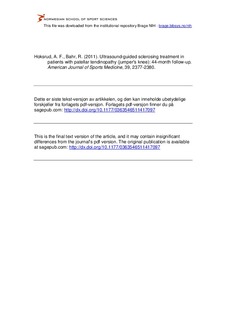| dc.contributor.author | Hoksrud, Aasne Fenne | |
| dc.contributor.author | Bahr, Roald | |
| dc.date.accessioned | 2012-09-28T11:50:26Z | |
| dc.date.available | 2012-09-28T11:50:26Z | |
| dc.date.issued | 2011-08-12 | |
| dc.identifier | Seksjon for idrettsmedisinske fag / Department of Sports Medicine | |
| dc.identifier.citation | American Journal of Sports Medicine. 2011, 39 (11), 2377-2380 | no_NO |
| dc.identifier.issn | 0363-5465 | |
| dc.identifier.uri | http://hdl.handle.net/11250/170936 | |
| dc.description | I Brage finner du siste tekst-versjon av artikkelen, og den kan inneholde ubetydelige forskjeller fra forlagets pdf-versjon. Forlagets pdf-versjon finner du på sagepub.com: http://dx.doi.org/10.1177/0363546511417097 / In Brage you'll find the final text version of the article, and it may contain insignificant differences from the journal's pdf version. The original publication is available at sagepub.com: http://dx.doi.org/10.1177/0363546511417097 | no_NO |
| dc.description.abstract | Background: A randomized controlled study has shown good clinical results after treatment with sclerosing injections into the area with neovessels in patients with patellar tendinopathy, but no study has investigated medium- or long-term outcomes.
Purpose: This study investigates the effect of sclerosing treatment 44 months (range, 42-47 months) after start of treatment.
Study Design: Case series; Level of evidence, 4.
Methods: Patients with a diagnosis of jumper’s knee and neovascularization corresponding to the painful area were recruited and treated with ultrasound-guided sclerosing injections using polidocanol. Primary outcome was Victorian Institute of Sport Assessment (VISA) score, which was recorded before the start of treatment, after 12 months, and 44 months after the start of the study period.
Results: Twelve of the 29 patients (14 tendons) who were followed up at 44 months had undergone arthroscopic surgery after sclerosing treatment, either to the patellar tendon (n = 6) or for other intra-articular lesions (n = 8). For patients who did not receive additional treatment after the sclerosing injections (n = 23 tendons), VISA score was 55 (range, 28-71) at baseline and 81 (range, 39-100) at 12-month follow-up (P < .001 vs baseline).Their VISA score at 44 months’ follow-up was 89 (range, 73-100; P = .047 vs 12 months). For patients who went through arthroscopic tendon surgery, VISA score was 53 (range, 39-71) at baseline and 71 before surgery (range, 48-98; P = .14 vs baseline). Their VISA score at 44 months was 91 (range, 76-100; P = .0.16 vs 12 months; P = .005 vs baseline). For patients who went through non–tendon surgery, VISA score was 45 (range, 15-69) at baseline and 57 (range, 32-95) before surgery (P = .29 vs baseline). Their VISA score at 44 months was 92 (range, 72-100; P = .006 vs before surgery; P < .001 vs baseline).
Conclusion: Sclerosing treatment with polidocanol was effective for the majority of the patients. Nevertheless, one-third elected to seek additional treatment through arthroscopic surgery during the 44-month follow-up period. | no_NO |
| dc.language.iso | eng | no_NO |
| dc.publisher | SAGE | no_NO |
| dc.subject | jumper's knee | no_NO |
| dc.subject | polidocanol | no_NO |
| dc.subject | color Doppler | no_NO |
| dc.subject | tendon | no_NO |
| dc.title | Ultrasound-guided sclerosing treatment in patients with patellar tendinopathy (jumper's knee): 44 month follow-up | no_NO |
| dc.type | Journal article | no_NO |
| dc.type | Peer reviewed | no_NO |
| dc.subject.nsi | VDP::Social science: 200::Social science in sports: 330 | no_NO |
| dc.subject.nsi | VDP::Medical disciplines: 700::Clinical medical disciplines: 750 | no_NO |
| dc.subject.nsi | VDP::Medical disciplines: 700::Sports medicine: 850 | no_NO |
| dc.source.pagenumber | 2377-2380 | no_NO |
| dc.source.volume | 39 | no_NO |
| dc.source.journal | American Journal of Sports Medicine | no_NO |
| dc.source.issue | 11 | no_NO |
